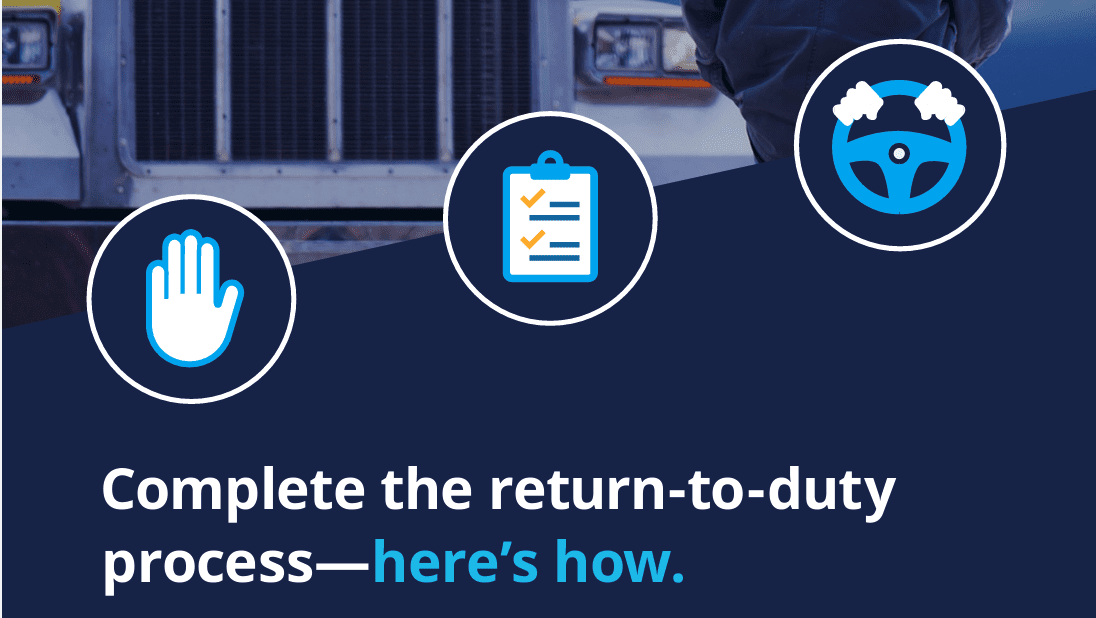The Return-to-Duty (RTD) process is a procedure that employees must follow after violating a drug and alcohol program rule. This process involves several steps, including evaluation, treatment, and follow-up testing, before the employee can return to safety-sensitive duties.
Upon a DOT violation, such as a positive drug test, the employee must first be evaluated by a Substance Abuse Professional (SAP). The SAP will determine what kind of assistance the employee needs, including education, treatment, follow-up testing, and aftercare.
Return-to-Duty drug tests are typically performed after one of three incidents occur:
1. A positive drug test.
2. Refusal to take a required drug test.
3. Other violations of drug and alcohol rules as determined by the employer or regulatory body.
These tests ensure that the employee has addressed the issue and is safe to return to work. It’s important to note that a negative RTD test result does not automatically qualify an employee to perform safety-sensitive functions. It indicates that the employee has met the requirements to begin the next step in the RTD process.
6.5.5 Return-to-Duty Process and Testing
The Return-to-Duty process and testing typically apply to employees who have violated a drug and alcohol program. The process ensures the employee can return to work after completing a treatment program. Here’s an overview of the process:
Substance Abuse Professional (SAP) Evaluation: An SAP must evaluate the employee after a violation. The SAP will determine what assistance the employee needs in resolving problems associated with drug use or alcohol misuse.
Treatment and Education: Based on the SAP’s recommendations, the employee may need to undergo treatment and education programs.
Follow-Up Evaluation: Once the employee completes the recommended treatment and education, they must undergo a follow-up evaluation by the SAP. This is to ensure that the employee has complied with their recommendations.
Return-to-Duty Test: If the SAP determines that the employee has successfully complied, the employee will need to take a Return-to-Duty drug and alcohol test. This test must show a result of less than 0.02 for alcohol and a negative impact for drugs.
Follow-Up Testing: After passing the Return-to-Duty test, the employee will be subject to unannounced follow-up tests for a period determined by the SAP (minimum of 6 trials in the first 12 months, but can extend up to 5 years).
Please note that this process can vary depending on the specific policies of an organization or industry regulations.
See 49 CFR 40, Subpart O—Return-to-Duty Process.
The 49 CFR Part 40, Subpart O—Return-to-Duty Process is a regulation by the Department of Transportation (DOT) that outlines the process for employees who have violated DOT drug and alcohol regulations to return to safety-sensitive duties. Here’s a brief overview:
Substance Abuse Professional (SAP) Evaluation: As an employee, if you have violated the DOT drug and alcohol regulations, you must be evaluated by an SAP. The SAP determines the necessary assistance needed to resolve issues associated with drug and alcohol misuse.
Treatment and Education: Based on the SAP’s recommendations, you may be required to complete treatment and education programs.
Follow-Up Evaluation: After completing the SAP’s recommended treatment and education, you must undergo a follow-up evaluation by the SAP to ensure compliance.
Return-to-Duty Test: If the SAP determines successful compliance, you must then take a Return-to-Duty drug and alcohol test. This test must result in less than 0.02 for alcohol and a negative result for drugs.
Follow-Up Testing: After passing the Return-to-Duty test, you will be subjected to unannounced follow-up tests for a period determined by the SAP (a minimum of 6 trials in the first 12 months, but it can extend up to 5 years).
Please note that as the employer, if you decide to allow the employee to return to safety-sensitive functions, you must ensure that the employee has complied with the SAP’s recommendations and has passed the Return-to-Duty test.

How Long Does A Return-To-Duty Process Take?
The Return-to-Duty process, as stipulated by the Department of Transportation (DOT), is a comprehensive procedure designed to ensure the safety and well-being of both employees and the public. This process becomes necessary when an employee fails a DOT drug test. There are several variables that can affect how long this process takes. Here’s a detailed look at the timeline.
Failed DOT Drug Test
You will be notified about a positive drug test result within 1-3 days. This marks the beginning of your return-to-duty process. It’s important to understand that a failed drug test does not necessarily mean immediate termination but requires immediate action.
SAP Treatment Program
After being notified about the positive test result, you’ll need to undergo an evaluation by a Substance Abuse Professional (SAP). The SAP will determine the appropriate treatment program for you, which could range from education programs to more extensive therapy or counseling. This initial evaluation and subsequent assignment to a treatment program usually occur within one week to 1 month after the positive drug test result.
Release from SAP Treatment
The treatment program’s length depends on the SAP’s recommendations and the individual’s progress in the program. Some individuals may complete their recommended treatment in a few weeks, while others may require several months. Upon successful completion, the SAP will conduct a follow-up evaluation to determine if you’re ready to proceed to the next step: the Return-to-Duty test.
Return To Duty Testing
The Return-to-Duty test is a critical step in the process. This test must show a blood alcohol concentration of less than 0.02 and a negative result for drugs. The time taken for this test and getting the results can vary, but typically, it’s completed within a few days.
Getting Back To Work
Once you pass the Return-to-Duty test, you can return to your safety-sensitive duties. This usually happens within 1-3 days after you complete your return to duty drug test. However, remember that the SAP will subject you to unannounced follow-up tests for a determined period.
When is a Return-to-Duty Drug Test Required?
A Return-to-Duty drug test is performed after one of three incidents occur:
1. A positive DOT drug or alcohol test
2. Refusal to take a required DOT test
3. Violation of other DOT drug and alcohol testing regulations
In conclusion, the duration of a Return-to-Duty process can vary greatly, from a few weeks to several months, depending on individual circumstances and compliance with the process. Please note that the design of this process ensures the safety of everyone involved and the public at large. Hence, adherence to it is of utmost importance.
Remember, the goal isn’t just to get back to work – it’s to do so in a way that ensures you’re healthy, safe, and ready to perform your duties effectively.


